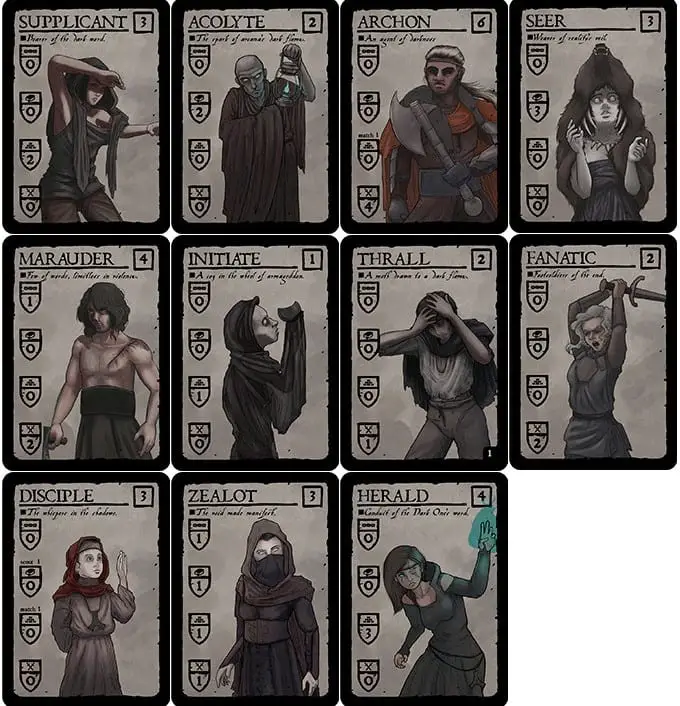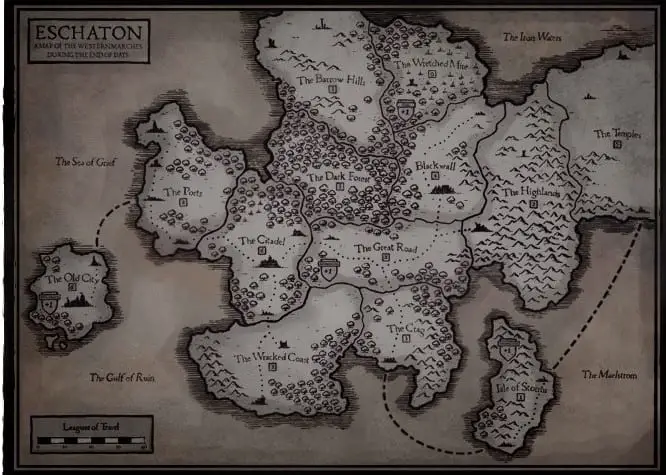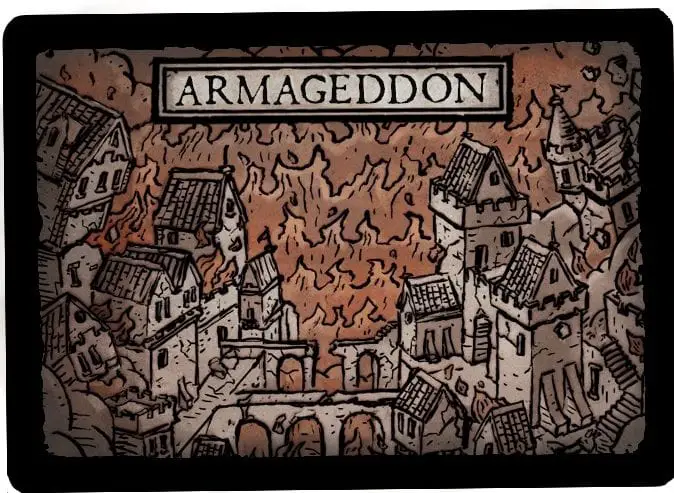(Blessings of the Dark One to the cultists at Archon Games for providing us a review copy of their game.)
The seas turn black, the king has gone mad, and women across the land give birth to unholy beasts. Some say these are merely freak incidents, that they will pass as they always have. But there are those who know the truth: these dark omens signal the doom of the world. These cursed oracles do not intend to go gentle into the fires of armageddon, and their dark followings grow even at the heart of things, the Citadel. From there they spread their unholy influence, summoning demonic beasts while spreading death and violence in the name of their dark master. But even as their power grows, they know their time is short. For the Dark One’s patience runs ever thin, and soon he will close his fist upon the world…and Eschaton will be upon us.
In Eschaton, players take on the role of a cult leader hoping to curry favor with The Dark One before the end of days kicks in. To do that, players must conquer land, gather followers, collect artifacts, and more while destroying any rival cult that stands in their way.
The game is mashup of a deck-builder and a strategy game, with each gathering power and influence that they then use to affect the world around them. The core of the game is “The Conclave,” a shared pool of followers each cult leader can recruit to their cause. These range from the lowly Thrall, meant only for the sacrificial pyer, or Initiate, who are only valuable en masse, all the way to the powerful Pontiff or Archon, mighty leaders who offer great power to your cult.

Each turn follows the order of the stats on each card, dictated by the five cards drawn at the start of each turn.
Zeal, represented by a chain, allows a player to bring more cultists to bear until their deck runs out. And yes, it stacks.
Wisdom, represented by a dark tome, allows a cult leader to draw from the Arcana deck to harness the dark powers contained within. That deck contains mighty demons like the Manticore, powerful artifacts that earn favor and bestow benefits to the cult, magic auras to increase your power, and dark edicts that change the face of the game when played.
Influence, represented as the building blocks of your cult, allow you to recruit new followers from The Conclave. The more you have, the more powerful the followers you can recruit. Influence also allows the use of powers: March, which allows extra moves for your armies, Dispel, which destroys plagues and auras, and Plague, which is cast on part of the board to winnow the occupying armies down and ripen the land for conquest.
The final stat is Aggression, and it is here that the game moves onto the board. With Aggression, a player may first place cubes that represent their armies into any territory they control (or at the Citadel if they have been wiped from the earth already). Then, they can move their cubes into adjacent territory so long as they leave at least one behind. Finally, they can use their remaining Agression to destroy the heretic cults in their lands. They must do this, as the Dark One looks favorably upon those who can dominate so effectively. Some even can buff your stats should you have the biggest presence.
At the end of the turn, the hand is discarded and a new one is drawn. If there is not enough, the discard pile is shuffled and the drawing continues.

There are a few unique mechanics that change the game as it goes along. The first is the Event deck,signs of the dark one drawn at the start of each round that inflict both positive and negative effects on the players. Within this deck are Omens, events which offer a quest of sorts to the cult leaders. If their requirement is met, and there is no tie, then the winning cult gains seven favor with The Dark One. These cards are slightly random, though any good cult can give you a vague idea of when the events might come. There will always be two Events and an Omen, until the final stack. Therein lies Armageddon. None but the Dark One know when the end will come, and thus players must be ready for their plans to go up in flames at any time when the Eschaton occurs and the game ends.
The other big game changer is the order of play. While it goes clockwise like many games, the same player will not go first each round. Rather, the player who goes first in a round, where each player takes their turn, will go last in the next. It creates a sense of helplessness in players, as their big land grab or newly built army is picked apart through plague and battle by their rivals.
The game is over when Armageddon is drawn. At that point, the players begin to count up their points of favor they’ve gained through sacrifices, summons, omens and land control. The one with the most influence is allowed to transcend the darkness that envelops the world, “walking at the Dark One’s side” for all eternity.

As I said in my Archon Games GenCon report, I’ve been a fan of Archon since they debuted Eschaton a few years back. The aesthetics alone were enough to shoot it to the top of my “I need it” list, and playtesting it the year it debuted just made my need worse. Getting to do a real deep dive into the game was an absolute treat, revealing even more nuance and character than I’d previously thought.
The game is different from its competitors in that it works hard to use its gameplay to capture both the story of the game as well as the feeling of being a cult leader at the end of days. There’s a cutthroat evil to it all that’s balanced with the pitch-black humor any good grimdark setting can’t go without. The turns of helplessness and confusion caused throughout the game help you slowly slip into your role and almost, maybe, go a little crazy too.
The setting is not just the usual grimdark, pulling heavily on actual medieval aesthetics and beliefs to create the monsters and mayhem of Eschaton. It also never really goes into too much detail with things, leaving the mechanisms of doom largely up to the player. It’s just nice to see a grimdark game without a juvenile preoccupation with rape.
The art, like in most Archon Games, goes a long way towards bringing the game to life. The board is drawn as if it is etched in wood, drawing influence from the woodcuts of the German Renaissance. The art of the cultists and monsters takes cues from medieval illumination, with many possessing a grotesque beauty all their own. Eschaton also reflects some of the more bizarre art from the Middle Ages, with creatures like the Lammasu and the Wyrm having faces that only the Dark One could love.
The game is one for hobbyists and it does run long, particularly with more players. Essentially, you’ll only want to pull Eschaton out for a dedicated group or with a group who’d have time to play something like Risk. But it outshines its competitors in that genre for being more fun, creative, and re-playable than, say, Stratego. Each cult can go for a different strategy in the game, from a monster-heavy wisdom cult to a cult that aims to recruit as many followers as possible. Do you go for the omens? Do you build power in one state? All are perfectly viable strategies that let no two games ever feel the same.
For its mix of medieval darkness and perfect melding of deck-building and strategy, as well as truly unique game feel, I give Archon’s Eschaton five out of five stars.
![]()
![]()
![]()
![]()
![]()
Tips for Extra Cult-y Goodness:
- Weave the tale of your cult as you go along. Think of why they might leave a few people in the Temples, or how your small garrison at the Citadel might react to a plague.
- Put one some good mood music. The best genre for Eschaton is probably atmospheric black metal, something from Wolves in the Throne Room or Summoning.
- Wear black cloaks. You know you want to.

